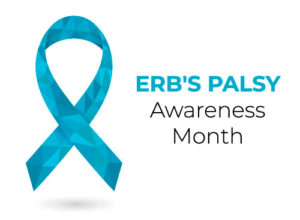What is Erb’s Palsy?
 Generally speaking, palsy is a term used to describe a muscle condition that causes paralysis, tremors, or weakness in parts of the body. Erb’s palsy (also called Erb-Duchenne palsy) is a type of brachial plexus palsy.
Generally speaking, palsy is a term used to describe a muscle condition that causes paralysis, tremors, or weakness in parts of the body. Erb’s palsy (also called Erb-Duchenne palsy) is a type of brachial plexus palsy.
The brachial plexus is a network of nerves in the upper arm near the neck that connects the spine to the arm and hand. This group of nerves allows the shoulder, arms, and hands to move. Erb’s palsy causes problems in this area of the affected arm or shoulder.
The brachial plexus can be injured in the following ways:
- Avulsion: Nerve rips away from the spinal cord (most severe type).
- Neurapraxia: Nerve is stretched but not torn (most common type).
- Neuroma: Nerve was torn and healed but left scar tissue.
- Rupture: Nerve is torn.
Erb’s palsy can sometimes happen during a difficult vaginal or cesarean section (C-section) delivery.
The condition often occurs when a baby’s head needs to be moved to one side to allow the shoulders to fit through the birth canal. This can cause healthy nerves to be stretched or torn, damaging the nerves.
What Causes Erb’s Palsy?
Erb’s palsy is often caused by damage to cervical nerves during childbirth. This type of Erb’s palsy is also called brachial plexus birth palsy, brachial plexus birth injury, or obstetric brachial plexus palsy.
The network of nerves involved lies behind the clavicle (collarbone) and spreads into the arms. When this system of nerve fibers is disturbed, damage can occur where the nerve roots come together to form the brachial plexus.
Risk factors for Erb’s palsy include high birth weight and births involving shoulder dystocia — when a baby’s shoulders get stuck inside the pelvis. Cases of Erb’s palsy can also occur based on how the baby was lying in the womb during pregnancy.
Medical Malpractice
In difficult deliveries, healthcare providers may need to stretch the baby’s neck to the side, so the baby doesn’t get stuck. They may also need to pull a baby out during a breech birth.
If these procedures are done too forcefully, they can cause the brachial plexus nerves to tear. This may be considered medical malpractice or medical negligence.
Medical mistakes that can cause Erb’s palsy include:
- Excessive force used to pull a newborn from the womb leading to nerve injury
- Failure by the obstetrician to perform a C-section when necessary
- Improper use of medical instruments such as forceps or vacuum extractors
If your child has Erb’s palsy, you may be the victim of medical malpractice. Fortunately, most babies recover from Erb’s palsy, but it is important to get the best treatment available. An Erb’s palsy legal claim may offer financial and emotional relief to new parents.
Money from an Erb’s palsy lawsuit can help you provide the best care for your baby to ensure they fully and quickly heal from their birth injury.
What Are the Erb’s Palsy Symptoms?
Erb’s palsy symptoms usually show up shortly after birth. While the symptoms of Erb’s palsy vary depending on severity, one of your baby’s arms may limply hang from their shoulder.
Other Erb’s palsy symptoms include:
- Bent or flexed arm that is held against the body
- No reaction to loud noises
- Palm that points outward with fingers curled
- Weak grip on one side of the body
- Weakness or paralysis of the shoulder, arm, or elbow
If your baby is showing any of these symptoms, contact us for a free consultation. The attorneys in our network have registered nurses on staff who can help you figure out what happened to your child.
Is Erb’s Palsy Permanent?
Many new parents wonder if Erb’s palsy is a lifelong condition. Thankfully, Erb’s palsy usually isn’t permanent, with 80-96% of babies recovering fully within their first year. However, there is no way to know how long a complete recovery will take.
Babies who do not recover within five months may need surgical treatment such as:
- Nerve graft: Splicing healthy nerves onto damaged nerves
- Nerve transfer: Using nerves from other muscles to restore the function of damaged nerves
- Release of joint contractures: Removing scar tissue from shoulder or elbow joints to increase range of motion
- Tendon transfer: Moving a healthy tendon from another part of the body to the affected arm
As your baby grows, your doctor may recommend treatment options. Since nerves recover very slowly, treatment could take up to two years.
During this time, your baby may need multiple pediatric doctor’s appointments for physical examination. Parents must take an active role in performing motion exercises with their babies. Physical and occupational therapy may also be required to improve the baby’s range of motion.
All these things can add up to a lot of time that can interfere with your job. They may also result in medical expenses that you did not plan for.
What’s worse, Erb’s palsy results in permanent disability in some cases. This can lead to a lifetime of expensive care. Therefore, it is essential to secure the money you need for the best Erb’s palsy treatment without delay. An Erb’s palsy lawsuit can help.
How Common is Erb’s Palsy?
According to the American Academy of Orthopaedic Surgeons (AAOS), 1-2 out of every 1,000 babies are born with Erb’s palsy. This adds up to about 12,000 Erb’s palsy cases per year.
Neonatal Erb’s palsy is most common in babies larger than average who need to be pulled out during delivery due to being stuck.
What’s the Difference Between Erb’s Palsy and Klumpke’s Palsy?
Erb’s palsy and Klumpke’s palsy are both brachial plexus injuries. However, while Erb’s palsy occurs in the upper arm, Klumpke’s palsy happens in the lower network of nerves that affect the forearm and hand. Cases of Klumpke’s palsy occur less frequently than cases of Erb’s palsy.
As with other brachial plexus injuries, there are four types of Klumpke’s palsy:
- Avulsion: This is the most serious type and happens when the nerve rips away from the spine.
- Neurapraxia: The most common type, this stretch injury does not tear the nerve and usually heals on its own within three months.
- Neuroma: Damage to nerve fibers leaves scar tissue that may press on healthy nerves, resulting in only partial recovery.
- Rupture: A Klumpke’s palsy rupture is a torn nerve caused by a stretch injury that usually heals on its own.
Klumpke’s palsy — also called Klumke-Dejerine palsy or Klumpke paralysis — may cause the hand to appear claw-like. That’s because the forearm, hand, and wrist are most affected.
Additional Klumpke’s palsy symptoms include:
- Drooping of one eyelid
- Limp or paralyzed arm
- Muscle weakness in the arm or hand
- Stiff wrist and hand joints
Like Erb’s palsy, Klumpke’s palsy can be caused by difficult births. It can also be caused by gestational diabetes and trauma to the arm or shoulder.
While Klumpke’s palsy will most likely result in a full recovery, it requires medical intervention more often than Erb’s palsy does.
When Is Erb’s Palsy Awareness Month?
 Erb’s Palsy Awareness Month occurs each October, with one week of the month being dedicated to the condition. Also called Brachial Plexus Injuries Awareness week, the United Brachial Plexus Network’s Awareness Committee offers suggestions on ways to participate.
Erb’s Palsy Awareness Month occurs each October, with one week of the month being dedicated to the condition. Also called Brachial Plexus Injuries Awareness week, the United Brachial Plexus Network’s Awareness Committee offers suggestions on ways to participate.
Raising awareness can help other families affected by Erb’s palsy find the resources and community they may not even know are out there. This could include finding the best Erb’s palsy doctors.
It may also help other families find out if they are eligible to access the critical funds needed for care through an Erb’s palsy settlement.
How Do I File an Erb’s Palsy Compensation Claim?
Since Erb’s palsy is not a condition many people have heard of, finding an experienced Erb’s palsy lawyer can be challenging. However, this makes it all the more important to find a law firm that knows how to prove Erb’s palsy cases.
LawFirm.com can connect you with an Erb’s palsy lawyer from our nationwide network who has:
- Access to key resources, such as medical experts
- A history of securing money in birth injury cases
- Nationwide availability
Our Erb’s palsy attorneys have the experience to handle these rare and challenging lawsuits. They will handle every aspect of your case, which means you can spend the critical first days and months of your baby’s life focusing on helping them recover.
Rest assured that you will not have to pay upfront fees to get help from the best Erb’s palsy lawyers. The attorneys we work with only get paid if you win.
 Get Legal Help Now
Get Legal Help Now
